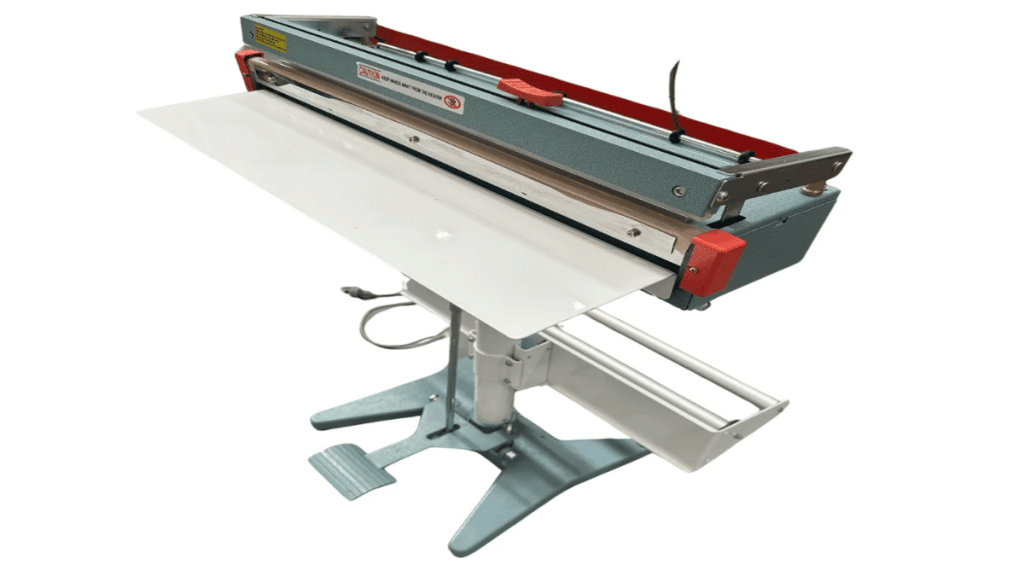A boost in Australian e-commerce stores has seen a significant need for more efficient packing processes. This can vary from choosing eco-friendly and sustainable wrapping materials to finding more effective ways to secure and safeguard packages of all types and sizes.
Fortunately, modern heat sealers have completely revolutionised every type of packing process and help business owners ensure product integrity and safety during the shipping process. A wide range of heat sealer models makes it super-easy for you to find the best model for your specific product and packaging needs.
What is a Heat Sealer?
Essentially, a heat sealer is a small or large device that uses heat to fuse two pieces of plastic or film over a product. When this happens, an airtight pocket forms over the item, which in turn, reduces the likelihood of the product becoming damaged or falling out of the bag.
Heat sealing machines typically use a minimum temperature of 120-123 degrees Celsius (140 degrees Fahrenheit) to create a sturdy and safe seal. Since heat sealers can easily seal plastic bags of various thicknesses as well as recycled material, users will be able to opt for thicker plastic bags better suited to delicate items.
Many Options to Choose From
Effectively sealing the products you’re selling is the most efficient way of providing a safe and professional product that isn’t broken, leaking, or lost when the box arrives at its destination. Since not all shipped products are the same, or encounter the same processes on their packaging journey, it makes sense to highlight that heat sealing machines aren’t a one-size-fits-all device.
With this in mind, our team of experts have compiled a list of the top types of heat sealers that you can choose from. Keep reading for a better understanding of the right heat sealer for your business.
1. Hot Bar Sealers
Also commonly referred to as constant heat sealers or even direct heat sealers, these models boast heated jaws (bars). These have been designed to apply steady pressure and heat to ensure a secure seal.
Unlike some other sealer types, hot bar sealers are able to maintain a constant heat to seal foil bags and thick laminates. Constant heat sealers are more commonly used in food packaging because a more secure seal ensures freshness and counters any potential contamination.
2. Impulse Heat Sealers
As one of the more common heat sealing options, impulse heat sealers are widely used for a wide range of packaging material types. The most common of these include films such as polypropylene and polyethene, which are the most used bag types for everything from food to jewellery.
An impulse heater uses a heating element that rapidly heats and cools down, which then creates a strong, airtight seal. This heat sealer model boasts user-friendly properties, and its affordability makes it a top choice for small startups.
3. Foot Pedal Heat Sealers
Some packaging materials may require the operator to have both hands free to handle. In these cases, the most common option is to use a foot pedal heat sealer. These models are essentially foot pedal heat sealers with foot pedal operation. This means you don’t need your hands to bring the upper bar down over the bags or films that need to be sealed.
Foot pedal heat sealers are more typically used in industries where control and precision are crucial to ensure a secure seal. Common examples here include electronics, medical, and automotive. Standout features of these heat sealer models include the following:
- Increased productivity
- Convenience
- Improved sealing accuracy
4. Pneumatic Heat Sealers
More fast-paced packaging processes may benefit from using pneumatic heat sealers. These models are heavy-duty sealers designed to use higher pressure than regular heaters. This aspect makes these models better suited to sealing tougher and thicker materials.
Pneumatic sealers are usually used in heavier industries such as aerospace, automotive, and manufacturing because reliable and robust sealing solutions are required. Users can look forward to uniform and consistent sealing pressures. A huge plus is that these units can be integrated into automated production lines.
5. Clamshell Sealers
Some packaging types require a tamper-evident seal, which is commonly found in retail products. Heat and pressure bonds to clamshell halves together, which then proves that the item hasn’t been opened when it gets to its destination. In addition to the security aspect, clamshell sealers also create an aesthetically pleasing presentation. Electronics, consumer goods, and cosmetic products are typically secured in these types of packages.
Final Thoughts
Heat sealers are among the most effective pieces of equipment to ensure that your products can easily and safely be secured. While smaller, desktop versions are ideal for small to medium packages being assembled at a slower pace, it may be a good idea to invest in a larger, foot pedal version for larger, more fast-paced packing requirements.
Speak to your local packaging specialist for a list of options best suited to your unique packaging requirements. Effective equipment will go a long way toward ensuring a streamlined process, which is excellent news for your bottom line!
Angela Spearman is a journalist at EzineMark who enjoys writing about the latest trending technology and business news.

